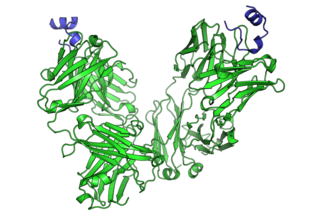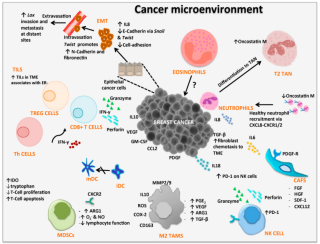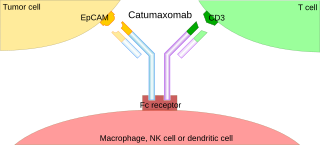Related Research Articles

Natural killer cells, also known as NK cells or large granular lymphocytes (LGL), are a type of cytotoxic lymphocyte critical to the innate immune system that belong to the rapidly expanding family of known innate lymphoid cells (ILC) and represent 5–20% of all circulating lymphocytes in humans. The role of NK cells is analogous to that of cytotoxic T cells in the vertebrate adaptive immune response. NK cells provide rapid responses to virus-infected cell and other intracellular pathogens acting at around 3 days after infection, and respond to tumor formation. Typically, immune cells detect the antigen presented on major histocompatibility complex (MHC) on infected cell surfaces, triggering cytokine release, causing the death of the infected cell by lysis or apoptosis. NK cells are unique, however, as they have the ability to recognize and kill stressed cells in the absence of antibodies and MHC, allowing for a much faster immune reaction. They were named "natural killers" because of the notion that they do not require activation to kill cells that are missing "self" markers of MHC class 1. This role is especially important because harmful cells that are missing MHC I markers cannot be detected and destroyed by other immune cells, such as T lymphocyte cells.
Immunotherapy or biological therapy is the treatment of disease by activating or suppressing the immune system. Immunotherapies designed to elicit or amplify an immune response are classified as activation immunotherapies, while immunotherapies that reduce or suppress are classified as suppression immunotherapies. Immunotherapy is under preliminary research for its potential to treat various forms of cancer.

Immunosuppressive drugs, also known as immunosuppressive agents, immunosuppressants and antirejection medications, are drugs that inhibit or prevent the activity of the immune system.

GD2 is a disialoganglioside expressed on tumors of neuroectodermal origin, including human neuroblastoma and melanoma, with highly restricted expression on normal tissues, principally to the cerebellum and peripheral nerves in humans.

Cancer immunotherapy is the stimulation of the immune system to treat cancer, improving on the immune system's natural ability to fight the disease. It is an application of the fundamental research of cancer immunology and a growing subspecialty of oncology.

Monoclonal antibody therapy is a form of immunotherapy that uses monoclonal antibodies (mAbs) to bind monospecifically to certain cells or proteins. The objective is that this treatment will stimulate the patient's immune system to attack those cells. Alternatively, in radioimmunotherapy a radioactive dose localizes a target cell line, delivering lethal chemical doses. Antibodies are used to bind to molecules involved in T-cell regulation to remove inhibitory pathways that block T-cell responses. This is known as immune checkpoint therapy.
Odulimomab is an investigational drug for the prevention of transplant rejection and for the treatment of various immunological diseases.
CD16, also known as FcγRIII, is a cluster of differentiation molecule found on the surface of natural killer cells, neutrophils, monocytes, macrophages, and certain T cells. CD16 has been identified as Fc receptors FcγRIIIa (CD16a) and FcγRIIIb (CD16b), which participate in signal transduction. The most well-researched membrane receptor implicated in triggering lysis by NK cells, CD16 is a molecule of the immunoglobulin superfamily (IgSF) involved in antibody-dependent cellular cytotoxicity (ADCC). It can be used to isolate populations of specific immune cells through fluorescent-activated cell sorting (FACS) or magnetic-activated cell sorting, using antibodies directed towards CD16.

Tumor necrosis factor ligand superfamily member 9 also known as 4-1BB ligand or 4-1BBL or CD137L is a protein that in humans is encoded by the TNFSF9 gene.

CD137, a member of the tumor necrosis factor (TNF) receptor family, is a type 1 transmembrane protein, expressed on surfaces of leukocytes and non-immune cells. Its alternative names are tumor necrosis factor receptor superfamily member 9 (TNFRSF9), 4-1BB, and induced by lymphocyte activation (ILA). It is of interest to immunologists as a co-stimulatory immune checkpoint molecule, and as a potential target in cancer immunotherapy.

Cancer immunology is an interdisciplinary branch of biology that is concerned with understanding the role of the immune system in the progression and development of cancer; the most well known application is cancer immunotherapy, which utilises the immune system as a treatment for cancer. Cancer immunosurveillance and immunoediting are based on protection against development of tumors in animal systems and (ii) identification of targets for immune recognition of human cancer.

A trifunctional antibody is a monoclonal antibody with binding sites for two different antigens, typically CD3 and a tumor antigen, making it a type of bispecific monoclonal antibody. In addition, its intact Fc-part can bind to an Fc receptor on accessory cells like conventional monospecific antibodies. The net effect is that this type of drug links T cells and monocytes/macrophages, natural killer cells, dendritic cells or other Fc receptor expressing cells to the tumor cells, leading to their destruction.
Adoptive cell transfer (ACT) is the transfer of cells into a patient. The cells may have originated from the patient or from another individual. The cells are most commonly derived from the immune system with the goal of improving immune functionality and characteristics. In autologous cancer immunotherapy, T cells are extracted from the patient, genetically modified and cultured in vitro and returned to the same patient. Comparatively, allogeneic therapies involve cells isolated and expanded from a donor separate from the patient receiving the cells.

Two chemically linked fragments antigen-binding form an artificial antibody that binds to two different antigens, making it a type of bispecific antibody. They are fragments antigen-binding of two different monoclonal antibodies and are linked by chemical means like a thioether. Typically, one of the Fabs binds to a tumour antigen and the other to a protein on the surface of an immune cell, for example an Fc receptor on a macrophage. In this way, tumour cells are attached to immune cells, which destroy them.
Ronald C. Kennedy was a virus immunologist at Texas Tech University. Prior to his appointment there he was affiliated with Baylor University, where he had previously done postdoctoral studies. Furthermore, when he switched affiliations to Texas Tech, he was also an adjunct, associate and full professor in the Departments of Microbiology and Pediatrics at the University of Texas Health Science Center at San Antonio. After his tenure in San Antonio, he switched affiliations to the University of Oklahoma Health Sciences Center's department of microbiology and immunology. In the 1980s he was affiliated with the Southwest Foundation for Biomedical Research, during which time he published some research pertaining to SV40 and intracellular protein transport. More recently, Kennedy has published some research regarding DNA vaccination, mostly in the journal Cancer Immunology, Immunotherapy.

Immune checkpoints are regulators of the immune system. These pathways are crucial for self-tolerance, which prevents the immune system from attacking cells indiscriminately. However, some cancers can protect themselves from attack by stimulating immune checkpoint targets.

PD-1 inhibitors and PD-L1 inhibitors are a group of checkpoint inhibitor anticancer drugs that block the activity of PD-1 and PDL1 immune checkpoint proteins present on the surface of cells. Immune checkpoint inhibitors are emerging as a front-line treatment for several types of cancer.

CKLF like MARVEL transmembrane domain-containing 6, previously termed chemokine-like factor superfamily 6, is a transmembrane protein encoded in humans by the CMTM6 gene. This gene is located in band 22.3 on the short arm of chromosome 3. CMTM6 protein belongs to the CKLF-like MARVEL transmembrane domain-containing family of proteins. This family consist of 9 member proteins: CKLF and CMTM1 through CMTM8. The CMTM family proteins are involved in autoimmune diseases, cardiovascular diseases, the male reproductive system, haematopoiesis, and cancer development. CMTM6 protein regulates immune responses to normal and abnormal cells.

Shimon Slavin is an Israeli professor of medicine. Slavin pioneered the use of immunotherapy mediated by allogeneic donor lymphocytes and innovative methods for stem cell transplantation for the cure of hematological malignancies and solid tumors, and using hematopoietic stem cells for induction of transplantation tolerance to bone marrow and donor allografts.
Oligoclonal antibodies are an emerging immunological treatment relying on the combinatory use of several monoclonal antibodies (mAb) in one single drug. The composition can be made of mAb targeting different epitopes of a same protein (homo-combination) or mAb targeting different proteins (hetero-combination). It mimicks the natural polyclonal humoral immunological response to get better efficiency of the treatment. This strategy is most efficient in infections and in cancer treatment as it allow to overcome acquired resistance by pathogens and the plasticity of cancers.
References
- 1 2 3 Offit, Paul (2011). Deadly Choices . Basic Books. p. 100. ISBN 9780465023561.
- ↑ Embleton, M. J.; Gunn, B.; Byers, V. S.; Baldwin, R. W. (1981). "Antitumour reactions of monoclonal antibody against a human osteogenic-sarcoma cell line". British Journal of Cancer. 43 (5): 582–587. doi:10.1038/bjc.1981.87. PMC 2010673 . PMID 6941806.
- 1 2 3 4 "Day 4 of the autism omnibus trial" (PDF). Retrieved 25 September 2013.
- ↑ Byers, V. S.; Henslee, P. J.; Kernan, N. A.; Blazar, B. R.; Gingrich, R.; Phillips, G. L.; Lemaistre, C. F.; Gilliland, G.; Antin, J. H.; Martin, P. (1990). "Use of an anti-pan T-lymphocyte ricin a chain immunotoxin in steroid-resistant acute graft-versus-host disease". Blood. 75 (7): 1426–1432. doi: 10.1182/blood.V75.7.1426.1426 . PMID 2180494.
- ↑ Baldwin, R. W.; Clegg, J. A.; Curran, A. C.; Austin, E. B.; Khan, T.; Ma, Y.; Gunn, B.; Hudecz, F.; Byers, V. S.; Lepoittevin, J. P.; Price, M. R. (1999). "Regulation of the contact sensitivity response to urushiol with anti-urushiol monoclonal antibody ALG 991". Archives of Dermatological Research. 291 (12): 652–658. doi:10.1007/s004030050470. PMID 10651166. S2CID 25186844.
- ↑ Kolata, Gina (24 November 1987). "Futuristic Treatments For the Hair and Skin". New York Times . Retrieved 12 February 2014.
- 1 2 Byers, V. S.; Levin, A. S.; Ozonoff, D. M.; Baldwin, R. W. (1988). "Association between clinical symptoms and lymphocyte abnormalities in a population with chronic domestic exposure to industrial solvent-contaminated domestic water supply and a high incidence of leukaemia". Cancer Immunology, Immunotherapy. 27 (1): 77–81. doi:10.1007/BF00205762. PMID 3260823. S2CID 7121793.